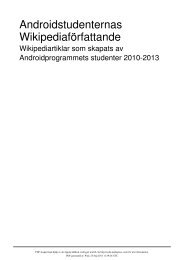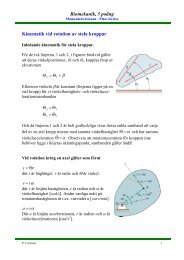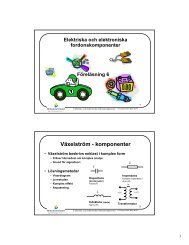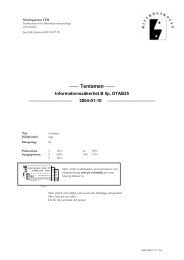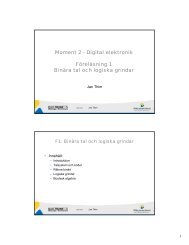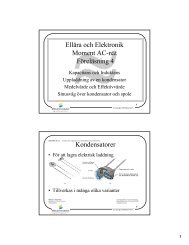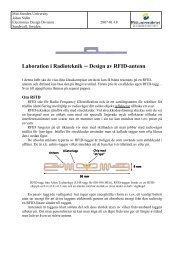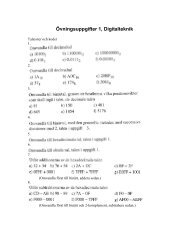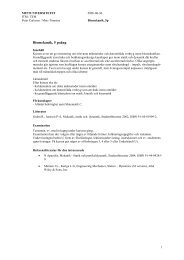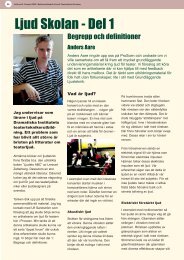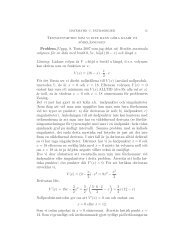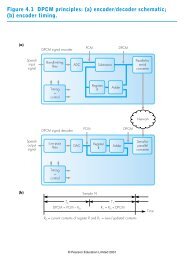Discrete Mathematics with Programming
Discrete Mathematics with Programming
Discrete Mathematics with Programming
You also want an ePaper? Increase the reach of your titles
YUMPU automatically turns print PDFs into web optimized ePapers that Google loves.
Director of Studies for <strong>Mathematics</strong>, that on a trial-basis she would allow the DMY students of<br />
spring 2009 the option to be assessed on participation and coursework alone, if they so desired.<br />
Further, they were given a ’free’ attempt at bettering their grades in that their course grade<br />
on the course would be their coursework grade or their tenta grade, whichever was the higher.<br />
This was done in order to encourage them to sit the tenta, as it is well known that during tenta<br />
revision many topics really root in student brains. Perhaps surprisingly most students decided<br />
not to sit the ’free’ tenta, supporting the theory of phobic angst suggested above. The complete<br />
method of assessment of the course of spring 2009 can be found in Appendix F.<br />
5 Conclusions and Future Developments<br />
The funding for the <strong>Discrete</strong> <strong>Mathematics</strong> <strong>with</strong> <strong>Programming</strong> project enabled us to develop a<br />
set of novel tools and approaches for teaching mathematics to computing students coming into<br />
university programmes of study <strong>with</strong> limited mathematical background. The feedback from<br />
the students during the beta-run in spring 2009 has been encouraging and we have thus already<br />
started adapting the tools and the resulting learning environment for use in other relevant<br />
courses.<br />
The <strong>Discrete</strong> <strong>Mathematics</strong> <strong>with</strong> <strong>Programming</strong> project shows what resource-based learning can<br />
achieve given sufficient resources. However, <strong>with</strong> a student base of around 30 students, a lecturer<br />
would not be allocated sufficient time to be able to prepare and give all the Marratech lectures,<br />
maintain the discussion boards and set and mark send-in exercises, even <strong>with</strong> a fully developed<br />
teaching material, so cuts will have to be made in the format to make the course format more<br />
realistic. PH is working on this aspect at the moment in her adaptation of the core elements of<br />
the project in other courses.<br />
PH has in the autumn of 2009 and spring of 2010 adapted the format and layout of the WebCT<br />
course in the three distance courses MA055G Matematisk introduktionskurs, MA025G Linjär<br />
Algebra I and MA057G Översiktskurs i Analys, and some of her experiences are helping in the<br />
design of a mathematics course for a new vocational study programme for processoperatörer <strong>with</strong><br />
a student base similar to that of DMY. PH also continues the development of the e-assessment<br />
material and some of the interdisciplinary lab exercises in the current <strong>Discrete</strong> <strong>Mathematics</strong><br />
courses MA001G and MA064G, both of which are campus courses, but <strong>with</strong> an added VLE<br />
component, making them blended learning environments.<br />
The ultimate vision is to have a flexible set of easily customisable e-learning tools suitable for a<br />
range of courses requiring a mathematical background at a variety of levels. Such tools would be<br />
very valuable in today’s fast moving teaching landscape in higher education institutions where<br />
programmes of study have to be adaptable to the needs of a fast moving society.<br />
8



